VASELINE
GLASS MANUFACTURERS
Vaseline
Glass was made by a variety of makers, both during the victorian times
and in modern times. The following list tells something about the a few
of the makers and their glassware. This list is by no means complete,
but
just a brief history of a few of the more popular companies to produce
Vaseline Glass. We have tried to add a picture under the
description
of the various glass makers to show some of the patterns made. (If you
have a good photo of one of the manufacturers that have no photo
displayed,
please send it to the email address below and we will try to add it!)
CLICK
ON ANY THUMBNAILIMAGE
TO SEE A LARGERPICTURE!
- Adams
&
Co.: Adams, Mackin & Co was established in Pittsburgh,
Pennsylvania
in 1851. In 1861, it became Adams and Co. In 1891, it became factory
'A'
in the U.S. Glass Co. Adams & Co. first made the 'Wildflower'
pattern
that has been reproduced numerous times in numerous colors. Adams &
Co. are also credited with making a lot of victorian novelties.
These two gypsy tubs are rare to find with lids intact. To find
out
more about Victorian novelty pieces, please refer to the article in the
March 1999 copy (Vol. 1, #3) of the GLOWING REPORT.
The second photo shows
the
rare "turtle salt." The salt is a "quadruple collectable," sought
after by vaseline collectors, open salt collectors, Wildflower pattern
collectors, and victorian novelty collectors. The third photo
shows
a rare child's ABC/CLOCK plate in the THOUSAND EYE pattern. The
last photo is a small wheelbarrow that was patented by James Dalzell in 1882. Dalzell was
working for Adams & Co. at that time. The design on the side
of the wheelbarrow is part of the 'GOOD LUCK' motif found on other
Adams' patterns. Revi (AMERICAN
PRESSED GLASS & FIGURE BOTTLES, pg. 100) believed it was part of
the BARLEY pattern from Bryce, Higbee. Dalzell previously worked
for Campbell, Jones and Co., but left their employ in 1880. The
original patent mentioned that this small wheelbarrow could be used as
a salt celler, match safe or other similar uses. The bottom photo
is a Child's mug that features a girl decorating a Christmas tree on
one side, a boy at a desk on the opposite side, and opposite the handle
is the entire alphabet. Vaseline glass is not a listed color in
any reference book for this novelty.
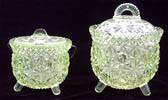 "No.
2 & No. 3 Gypsy Pots, with lids", Adams & Co., ca 1885-1895.
"No.
2 & No. 3 Gypsy Pots, with lids", Adams & Co., ca 1885-1895.
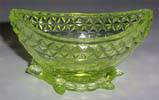 Wildflower
Turtle Salt, Adams & Co., c. mid-1880's.
Wildflower
Turtle Salt, Adams & Co., c. mid-1880's.
 ABC/CLOCK
child's plate in 1000 EYE pattern, Adams & Co., mid-1880's.
ABC/CLOCK
child's plate in 1000 EYE pattern, Adams & Co., mid-1880's.
 GOOD LUCK small wheelbarrow salt or match
safe, Adams & Co., 1882.
GOOD LUCK small wheelbarrow salt or match
safe, Adams & Co., 1882.
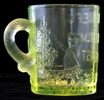 A rare CHILDREN & A.B.C.D. mug in
vaseline glass, Adams & Co., circa mid-1880's
A rare CHILDREN & A.B.C.D. mug in
vaseline glass, Adams & Co., circa mid-1880's
- Aetna:
The Aetna Glass and Manufacturing Co. was founded in Bellaire, Ohio in
1880 and stopped production in 1889. they primarily produced
goblets.
They also had their own foundry and mold shop for producing molds for
their
own use and for others. The HOBNAIL IN SQUARE pattern shown here
is the only known pattern made by the factory that was made in
canary.
The pattern was originally called No. 335 1/2 and was introduced
in 1886. Metz II mentions that it was made in an open sugar, a
covered
sugar, spooner, covered butter, creamer, and a sauce bowl. No
mention
was made of a mug.
 No.
335 1/2, also known as HOBNAIL IN SQUARE by Aetna Glass, introduced in
1886.
No.
335 1/2, also known as HOBNAIL IN SQUARE by Aetna Glass, introduced in
1886.
- Baccarat:
The name 'Baccarat' is synonymous with fine crystal. In 1843,
they
made their first vaseline glass, calling it cristal dichroide.
It is unknown when they stopped making it, but it was not made for any
extended period of time. Of the few pieces seen today, most are
always
marked with raised text: BACCARAT. Any piece found is generally
fine
crystal and will sing when flicked with a fingernail. Here is a
rare
open salt (or possibly a small nut dish), that is marked on the
inside.
Click on the small photo to see the raised lettering.
 Baccarat
open salt (or nut cup), 2.5" diameter X 1.75" tall, c. pre-1900.
Baccarat
open salt (or nut cup), 2.5" diameter X 1.75" tall, c. pre-1900.
- Bayel
Crystal:
Bayel is known as the City of Crystal in France. Glass has been
documented
as being made at that location since 1666. Their glass is
crystal,
being 24% lead oxide or better. They are known for both clear and
colored glass. Not much is known about this small statue of a
parrot,
other than it is marked BAYEL CRYSTAL FRANCE on the base and it is high
quality glass of excellent clarity. This piece is one piece and
was
molded. The base of the tail is vaseline, fading to a teal
color.
At the point where the vaseline stops and the clear glass starts, it is
a clean division with no bleed from one area to the other. The
head
looks like it contains vaseline glass, but that is the reflection from
the tail area, reflecting internally through the glass. When the
piece is turned, the yellow flashes in different parts of the
body.
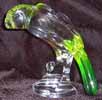 Bayel
Crystal Parrot and Cockatoo - age unknown, but contemporary.
Bayel
Crystal Parrot and Cockatoo - age unknown, but contemporary.
- A.J.
Beatty
& Sons: This glass factory evolved out of the
Steubenville
Flint Glass Works, Steubenville, OH in 1863. In 1888, the company
opened an additional facilitiy at Tiffin, OH, and continued to operate
both factories for a while. In 1891, the company joined US Glass Co.
and
the Tiffin sight became known as 'factory R' and the Steubenville sight
became known as 'factory S'. Three particular patterns in
vaseline
to look for are BEATTY SWIRL, DAISY AND BUTTON with V ORNAMENT, and
OVER
ALL HOBS. Here is a Over All Hobs Spooner. It has an
unusual
footed base that has an added sprue in-between the feet and there are
also
hobs on the bottom of the item.
 Over
All Hobs footed spooner by A.J. Beatty & Co.
Over
All Hobs footed spooner by A.J. Beatty & Co.
- Beaumont
Glass Co: The Beaumont Glass Co. was located in Martins Ferry, WV,
and was operated by Percy Beaumont, who was the brother-in-law of Harry
Northwood and worked with Northwood. When Northwood left Martins Ferry
in 1892, Beaumont stayed behind and the factory became Beaumont Glass.
In 1893, Beaumont made a line of pressed glass that was referred to as
"Columbia", named after the Columbian Exposition of that year. This
pattern
is now referred to as "Beaumont's Columbia". The original name
was "No. 100 or Columbia".
 "Beaumont's
Columbia" tobacco jar pickle castor, ca. 1893 (with pickle jar catalog
illustration as insert).
"Beaumont's
Columbia" tobacco jar pickle castor, ca. 1893 (with pickle jar catalog
illustration as insert).
 FLORA
spooner, by Beaumont, circa 1898.
FLORA
spooner, by Beaumont, circa 1898.
- Bellaire
Goblet Co.: This company was started in Bellaire, Ohio in 1876 and
moved to Findlay, Ohio in 1888. It joined the U. S. Glass Co.
combine
in 1891 as Factory M. It was out of business by 1892. This
rare goblet is one of the few items known to have been made by Bellaire
in vaseline. They did not make any vaseline glass after moving to
Findley, so this dates this piece between 1885-1888.
 Paneled
Rosettes Goblet, Bellaire Goblet Co., c. 1885-1888.
Paneled
Rosettes Goblet, Bellaire Goblet Co., c. 1885-1888.
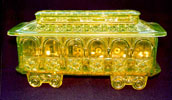 Train
Cookie Jar, Bellaire Goblet Co.
Train
Cookie Jar, Bellaire Goblet Co.
- Belmont
Glass Co.: There is very little known about this
company.
They were in business from 1866-1890 in Bellaire, OH. They did make a
nice
item commonly referred to as Daisy & Button with Lace that has a
lacy
trim around the outside edge. It is also referred to as
"Belmont",
or "Belmont #100". This very rare cakeplate just showed up on
ebay
recently and was not documented in any text as existing previous to
this.
Known pieces before this included creamer, butter, sugar, spooner, and
footed sauce bowl. The bottom photo shows the same pattern in the 10
pc.
ice cream set. The center dish is for spoons. All of the
pie-shaped
dishes can be removed from the underplate.
 Footed
cakeplate by Belmont Glass Co.
Footed
cakeplate by Belmont Glass Co.
 Belmont
#100 ice cream set.
Belmont
#100 ice cream set.
- Bohemian
Glass (maker unknown): I try to attribute all glass to a particular
maker, but the best I can do on this is attribute it to the Biedermeier
age, which was 1840-1850.
 A
grouping of Bohemian goblets, made in the Biedermeier age, circa 1840.
A
grouping of Bohemian goblets, made in the Biedermeier age, circa 1840.
- Boston
and
Sandwich Glass Company: (quoted from "American Glass" by Mary
Harrod
Northend, published 1926) "In 1825, A Flint-Glass Manufactory was
established
by individual enterprise in Sandwich, Mass. Ground was broke in April,
dwellings for the workmen built, and manufactory completed; and on the
4th day of July, 1825, they commenced blowing glass--three months from
first breaking ground. In the following year it was purchased of the
proprietor,
a company formed, and incorporated under the title of Boston and
Sandwich
Glass Company. The HORN OF PLENTY plate shown in the first photo
was offered for sale on eBay in 11/2002 for an opening bid of
$1,150.
Only 3 examples of this 6.25" plate are known to exist. One is in
the Bennington Museum and the other one just sold at Green Valley
Auctions
for $1,150. (Photo courtesy of Al Warr.) Also pictured here is a
perfume
bottle manufactured by the Boston & Sandwich Glass Co. The
perfume
bottle is shown in the Barlow-Kaiser book entitled: A GUIDE TO SANDWICH
GLASS, VASES, COLOGNES & STOPPERS and is identified as item
#3112.
It is 5.5" tall and was Blown Molded. A clear glass cologne
identical
to this one was dug up in almost perfect condition at the B&S
site.
It is so heavy that it holds very little. There are six large
convex
circles around the body, with six almond-shaped ovals above. The
stopper has an air trap in its center, indicating that it was blown
into
a mold. This cologne bottle is the color that is usually referred
to in old glass books as the true CANARY color. The third photo is of a
pedestal master salt. One of these is in the Boston and Sandwich
Museum. Barlow and Kaiser give a value to this item at $375.
 HORN
OF PLENTY pressed glass plate, Boston & Sandwich, c. 1850's.
HORN
OF PLENTY pressed glass plate, Boston & Sandwich, c. 1850's.
 Boston
& Sandwich Glass Co. cologne bottle, c. 1840-1870.
Boston
& Sandwich Glass Co. cologne bottle, c. 1840-1870.
 PRESSED
BALL AND GROOVE SALT by Boston and Sandwich
PRESSED
BALL AND GROOVE SALT by Boston and Sandwich
- Boyd's
Crystal
Art Glass: Cambridge OH. One of the very few remaining companies
still
making vaseline glass. Established in 1978. Originally the Degenhart
factory.
Boyd uses some original molds and they have also purchased some older
molds,
like the Imperial candlewick mold pictured here.
 This
candlewick dish (limited to 200 pcs.) was made for VGCI.
This
candlewick dish (limited to 200 pcs.) was made for VGCI.
- Bryce
Bros:This
company was founded in 1850 and located in Mt. Pleasant, Pennsylvania.
It specialized in hand blown stemware and stemware that was engraved,
etched,
cut, or decorated. It also had a line of baskets, vases, and accessory
pieces. Bryce Bros. Co. became a part of U.S. Glass Co. in 1891, known
as Factory 'B'. During sometime in the 1880's, there are references
that
they were in Pittsburgh, PA. This butter dish is known as 'LORNE',
which
is the original factory name. This was made while Bryce Bros. were
Factory
'B'. The underplate is attached/molded to the base. It is a very pale
yellow
in natural light. The toothpick holders shown in the second photo
were all made from the same mold and then the glassworker would crimp
or
curl the edge differently. These are the four shapes it was made
in this Daisy & Button pattern. The original name was
'Fashion'.
The far left one was recently named 'Fashion Fan' and was previously
undocumented
until an article appeared in the GLOWING REPORT, May, 2000, issue.
 "LORNE"
butter dish, made by Bryce Bros. Co.
"LORNE"
butter dish, made by Bryce Bros. Co.
 "Fashion"
toothpick holders by Bryce Bros., Co.
"Fashion"
toothpick holders by Bryce Bros., Co.
- Buckeye
Glass Co.:
This company was founded in 1878 in Martin's Ferry, Ohio, by wealthy
capitalist, Henry Helling. John F. Miller was the Secretary before
Helling purchased the factory from Excelsior (Glass)Works and changed
the name. In 1887, Harry Northwood joined as General
Manager. In 1888, Pattern #528 (REVERSE SWIRL) was made
in a variety of shapes and colors. Later in 1888, Miller left the
company, but returned in 1891, and he was known to have been at Model
Flint Glass Co. in 1901. REVERSE SWIRL was made at both
locations, but it is believed the lamp shown here was only made at
Buckeye Glass. Because of the distinctive pattern on the clear
base, this lamp is frequently referred to as SHELDON SWIRL. It is
known to have been made in two sizes with this clear foot. It was
also made in a finger lamp.
 SHELDON
SWIRL (aka, No. 528, Reverse Swirl), Buckeye Glass Co., circa 1888.
SHELDON
SWIRL (aka, No. 528, Reverse Swirl), Buckeye Glass Co., circa 1888.
- Burtles,
Tate & Co.: This company was located in Manchester,
England.
In 1891, the company's new "Topas Opalescent" ware was described as a
'striking
imitation of the old Venetina Topas'. (from The Identification of
English
Pressed Glass, 1842-1908, by Jenny Thompson) Thompson: "In
reality, it was similar to the Davidson Pearline of 1889, although the
Burtles, Tate & Co. pieces are considerably harder to find today."
The elephant flower holder design was registered on 12/28/1886 as Rd.
64234.
The mermaid flower trough features a motif of shells along the sides of
the boat, with a mermaid masthead at each end. The sugar bowl has
been given the generic name of PINWHEEL. There is no Rd. number
on
the sugar bowl. Other pieces known to exist by this company
include
a flower shoe (Rd 65455), another style of boat (Rd. 29106), wall
bracket
(Rd. 39807) and a swan (Rd. 20086).
 Elephant
flower holder (Rd. 64234)
Elephant
flower holder (Rd. 64234)
 Mermaid
flower holder (Rd. 44445)
Mermaid
flower holder (Rd. 44445)
 Shoe
flower vase (Rd. 65455)
Shoe
flower vase (Rd. 65455)
 Flower
Trough in boat shape (Rd. 29106)
Flower
Trough in boat shape (Rd. 29106)
 Wall
bracket for flowers (Rd. 39807)
Wall
bracket for flowers (Rd. 39807)
 Swan
flower vase (Rd. 20086)
Swan
flower vase (Rd. 20086)
- Cambridge
Glass Co.: Cambridge Glass Company started out as a factory
in
the National Glass combine. The combine signed a contract with
the
city of Cambridge, Ohio, to construct a glass factory in one
year.
This was in approximately 1901. In May, 1902, they started
production.
In 1907, National went bankrupt and local investors bought the plant
from
them. They became Cambridge Glass Co. in 1907 and operated until
1958. Cambridge brought 'elegance and beauty' to the masses,
becoming
one of the biggest producers of hand-made glass in the 1920's.
They
did this through an innovative national advertising campaign.
They
introduced color to the extent that it was the norm, rather than the
exception.
The Volstead Dog is one of the more famous pieces of vaseline glass
produced
by Cambridge. The bottle holds about 8 oz. of liquid and the
shot-glass
'hat' holds barely one ounce. Everyone I have ever seen in this
pattern
has a ground top, which is how it must have been made from the
factory.
There is also a cat made like this, but it is even more rare to find in
vaseline glass. The Keg decanter set is known simply as "#1 KEG"
. It was made in several colors, including a blue. In
vaseline, it was made in both transparent and frosted (satin) versions.
Cambridge called this color TOPAZ. They also made a color with a
hint of additional green (that glows), called PISTACHIO.
 VOLSTEAD
dog novelty flip up bedside decanter, by Cambridge Glass Co., c. 1923.
VOLSTEAD
dog novelty flip up bedside decanter, by Cambridge Glass Co., c. 1923.
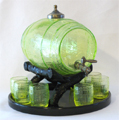 #1 KEG set in transparent vaseline with
original ebony stand & underplate. It was also made in
frosted vaseline.
#1 KEG set in transparent vaseline with
original ebony stand & underplate. It was also made in
frosted vaseline.
- Central
Glass: 1863 to 1891. (Oesterling & Co. 1863-1867) (Central
Glass
Co. 1867-1891)(Central Glass Works 1895-1939). (Became Factory 'O' with
US Glass in 1891-1895). The plant finally closed in 1939, with Imperial
buying their molds and machinery. Specialities
included
stemware, novelties, lamps, and tableware. There were
several items that they made in canary. The fish creamer (first
photo)
is extremely rare. This particular one is located in the West
Virginia
Glass Museum. The second photo is courtesy of Marilyn Hallock,
author
of the only book exclusively about Central Glass. It is a
"Barrel"
spooner. The very bottom photo is of the No. 764 oval flower
bowl.
Marilyn Hallock, stated that she has been looking for Central Glass for
10+ years and has never seen one in any color, other than a blue
version
in the Oglebay Museum (Wheeling, WV). The photo of the Stove
castor base is courtesy of Nancy Villaverde. Four daisy and
button bottles and a wire handle are needed to complete the novelty
piece.
 FISH
creamer, Central Glass Co., c. mid-1880's.
FISH
creamer, Central Glass Co., c. mid-1880's.
 BARREL
spooner, Central Glass Co., c. mid-1880's.
BARREL
spooner, Central Glass Co., c. mid-1880's.
 Extremely
rare! Oval Flower Bowl, pattern No. 764.
Extremely
rare! Oval Flower Bowl, pattern No. 764.
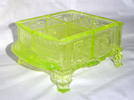 Stove castor base, pattern No. 822,
approximately 1887.
Stove castor base, pattern No. 822,
approximately 1887.
- Challinor,
Taylor & Co., Ltd.: C, T & Co. was organized in 1885
in Tarentum, PA. They specialized in tableware, novelties, opal
ware,
opaque, and mosaic glassware. David Challinor held a patent for
mosaic
(marble or slag) glass. In 1981, the company joined the U.S.
Glass
conbine. Here is a very rare picture of a child's mug called
"BIRD
IN NEST WITH FLOWERS". On one side of the mug there is a bird,
showing
a nest with 3 eggs in it. On the other side of the mug is the
same
nest, but there is a bird sitting on the nest and a bird hovering
nearby.
The best feature of this mug is that when you look in the bottom of the
cup, there is a surprise! CLICK
HERE to see the surprise! Pictured below the mug is a very
scarce
lace edge compote.
 Child's
mug BIRD WITH NEST ON FLOWERS by Challinor, Taylor & Co.
Child's
mug BIRD WITH NEST ON FLOWERS by Challinor, Taylor & Co.
 Lace-edge
compote by Challinor, Taylor & Co.
Lace-edge
compote by Challinor, Taylor & Co.
- Cooperative
Flint Glass Co.: This firm started out as the Beaver Falls
Co-operative
Flint Glass Co. in 1869, later changing their name (in 1889) to
Co-operative
Flint Glass Co. The firm operated until 1937, closing due to the
economic depression. Coop Flint made tableware and novelties in
canary.
The pattern commonly called 'Currier & Ives' (commonly mistaken for
having been made by Bellaire Goblet Co.) was actually a product of
Cooperative
Flint Glass Co. in the late 1880's. It was first reported to have
been made in clear, amber, blue and milk glass and this misinformation
continued, with authors copying the works of previous authors.
Approximately
35 different pieces were made in this pattern. It is very scarce
in canary/vaseline. The pattern picked up the name, 'Currier
&
Ives' due to the water tray. It pictures a 'balky mule' being
pushed
by two people. It reminded people of an old Currier & Ives
print.
 "No.
130 Currier and Ives cup, by Coop Flint Glass Co.
"No.
130 Currier and Ives cup, by Coop Flint Glass Co.
- Coudersport:
"Coudersport" is actually a generic term for a factory that was
operated
between 1900 - 1904 in Coudersport, PA. The factory had on and
off
production, and three different owners. The first company name
was
Webb Patent Tile Co./Joseph Webb Glass Company. This company was
in business from 1900-1901. A newspaper account on Nov. 7, 1900
stated
that an 'Endless Vine' pattern was being produced. The factory
closed
in May or June, 1901. In September, 1901, the factory reopened as
Ladona Glass Company, making fruit jars, bottles and wide-mouthed
ware.
This lasted until sometime in early, 1902. In October 1903, Harry
Bastow reopened the plant, under the name of Bastow Glass
Company.
He had previously been in charge of Jefferson Glass Co. in
Steubenville,
OH. Bastow advertised blown decorated glassware and novelties in
a variety of colors. He was also in possession of the 'Endless
Vine'
molds. The presumption is made that it was Bastow who made
several
whimsey novelties out of the various "Endless Vine' molds in both
canary
opalescent and blue opalescent. The factory burned to the ground
on May 8, 1904. There is about a 7 month "window of opportunity"
that the TRAILING VINE ('Endless Vine') pattern was made in novelty
pieces
in vaseline opalescent. The mold work was done by Webb Glass, but
the opalescent vaseline glass was most likely only made by Bastow (who
had made it previously at Jefferson Glass Co.). This card
receiver
bowl was made from the sugar mold and the rim for the lid can be seen
around
the top outside edge.
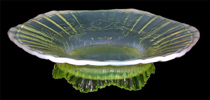 TRAILING
VINE card receiver whimsey, made from a sugar base mold, circa 1904.
TRAILING
VINE card receiver whimsey, made from a sugar base mold, circa 1904.
- Geo.
Davidson
& Co.: (1867 to at least WWII) The primary period
Vaseline
glass collectors are concerned with regarding this English Pressed
Glassmaker
is from 1889-1908. This was probably the most prolific English
(pressed)
Opalescent glassmaker as far as vaseline glass collectors are
concerned.
Their name for Opalescent vaseline glass was called Pearline Primrose
(Yellow
Opalescent). For the most part, the easiest way to distinguish
English
pressed glass from American pressed glass is that the yellow is a much
'richer' yellow, with hardly a hint of green and the opalescent
qualities
of Davidson glass was a very opaque creamy color. As you can see
from the picture, the opalescent treatment can only be described as
"rich
and
creamy"! This lampshade is what has been named by collectors as
'William
& Mary". The second piece shows a 'War of the Roses" boat
with
a vintage carriage. Some of these are found with a contemporary
carriage
on them, but this one is vintage and the boat cannot be removed without
damage to the carriage. A recent catalog discovery by John Bell,
one of our members from Great Britain, shows that Davidson at least
made
some Primrose Pearline in 1912, the date of the catalog. The
pieces
illustrated were five different sizes of shallow dishes, shaped like
shells,
that were used for ice cream or banana splits. The bottom photo
is
one of those dishes. A correction to VASELINE GLASS: CANARY TO
CONTEMPORARY:
color photo #260 has now been identified as made by Davidson, due to
that
catalog page from 1912. The bottom photo shows the SOMERSET
pattern (Rd. #254027).
 "William
and Mary" pattern, lampshade, c. 1900 by Davidson.
"William
and Mary" pattern, lampshade, c. 1900 by Davidson.
 War
of the Roses canoe with vintage metal carriage, c. 1893 by Davidson.
War
of the Roses canoe with vintage metal carriage, c. 1893 by Davidson.
 "Shell"
ice cream dish, illustrated in 1912 Davidson catalog
"Shell"
ice cream dish, illustrated in 1912 Davidson catalog
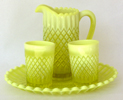 Somerset water set. LINK shows other
pieces in the pattern.
Somerset water set. LINK shows other
pieces in the pattern.
- Degenhart
Glass Co.: (also known as the Crystal Art Glass Co.) 1947 to 1978.
Mostly made small novelties. Sold to Boyd's in 1978. Here are a
couple
of little dogs that were made at Mosser for the Degenhart Museum.
The bigger of the two has been irridized, the small has not. You
can see the 'D' within the Heart emblem and then underlined on
the
dog's hind quarters and , which is the logo for the Degenhart
Museum.
The bigger dog is 1 9/16" tall and the shorter one is 1" tall.
Both
have a ground bottom that is unpolished. Below the pooches, there
is a picture of a Degenhart Gypsy Kettle. As all molds that were
owned by this company now belong to Boyd's, they continue to make
it.
This one, however, has the 'D' outlined by a heart. When you
click
on the pic, you can see this in the bottom of the kettle.
 These
Deganhart dogs are solid glass and named "Louise".
These
Deganhart dogs are solid glass and named "Louise".
 "Gypsy
Kettle" by Degenhart Glass Co.
"Gypsy
Kettle" by Degenhart Glass Co.
- John
Derbyshire:
Derbyshire was a manufacturing firm, located in Salford, Manchester,
England
from approximately 1874 - the turn of the century. This photo is
of a large piano or furniture coaster in the shape of a lion's paw.
 Lion's
Paw furniture coaster by Derbyshire, late 19th century.
Lion's
Paw furniture coaster by Derbyshire, late 19th century.
- Doyle
&
Co.: This glass house started in 1866 in Pittsburgh. They
were
one of the 'late-joiners' to the U. S. Glass combine, joining about 6
months
after U. S. Glass was first formed. Very little vaseline glass
was
made by this firm. Ruth Webb Lee mentioned in her book (EAPG)
that
the pattern known as "Hobnail with Thumbprint Base" was made in clear,
amber, and blue. It seems everyone else felt she was an authority
on it, as I have checked numerous references on this pattern and not
one
mentions vaseline or canary being made by this company. The
possibility
exists that this color was made after Doyle joined U.S. Glass, as they
pressed the pattern in 1893 and again in 1898.
 "Hobnail
with Thumbprint Base" fingerbowl, made by Doyle & Co.
"Hobnail
with Thumbprint Base" fingerbowl, made by Doyle & Co.
 "Hobnail
with Thumbprint Base" salt and pepper set, made by Doyle & Co.
"Hobnail
with Thumbprint Base" salt and pepper set, made by Doyle & Co.
 ACORN PICKLE
by Doyle & Co., circa 1880s.
ACORN PICKLE
by Doyle & Co., circa 1880s.
- Dugan
Glass:
bought the old Northwood factory in Indiana, PA in 1892. Became Diamond
Glass in 1913. Destroyed by fire 1931. This 'corn' vase in
opalescent
vaseline is one of their more popular pieces.
 "Corn
Vase" by Dugan Glass
"Corn
Vase" by Dugan Glass
- Geo.
Duncan
and Sons: This factory started when George Duncan bought out his
partner
in the Ripley Glass Co. in 1874. Duncan's daughter, Susan,
married
A. H. Heisey, who later became a partner in this firm when George
passed
away in 1877. The factory became known as Duncan and Heisey in
1886
and joined the U. S. Glass combine in 1891. By 1892, the company
was out of the combine and functioning as Geo. Duncan and Sons &
Co.,
until 1900, when it became Duncan and Miller. Below are hat and cap
novelties
made by Duncan. The 'sailor cap' open salt was made from
1886-1890.
It has a woven straw pattern, a ribbon around the crown and the ribbon
crosses in the front and is held in place with a 5-pointed star.
The sailor cap is oval shaped. The other photo shows four
different
Duncan hat novelty pieces. (From left to right): toothpick,
spooner,
open salt, smooth-brim cigarette or match holder. To find out how
to tell the difference between the Duncan toothpick and the Fenton
reproduction,
see the March, 2000 edition of the GLOWING REPORT!
 "Sailor
Cap" Open Salt dish, Duncan, circa 1886
"Sailor
Cap" Open Salt dish, Duncan, circa 1886
 Duncan
5-bottle castor set, c. 1885 (photo courtesy Gary
Wilson)
Duncan
5-bottle castor set, c. 1885 (photo courtesy Gary
Wilson)
- Duncan
&
Miller: started as Geo. Duncan & Sons, renamed to Duncan &
Miller in 1900. Closed in 1955 and patterns were taken over as part of
U. S. Glass -- Duncan and Miller Division. This Nautical lantern is one
of their more difficult pieces to find. There were three pieces that
came
in this particular shape: a small cigarette container, a decanter with
stopper, and this candy jar. The compote is even more difficult to find!
 Nautical
Candy Jar in the Sanibel pattern by Duncan & Miller.
Nautical
Candy Jar in the Sanibel pattern by Duncan & Miller.
 Nautical
anchor compote, one of two known to exist in vaseline opalescent!
Nautical
anchor compote, one of two known to exist in vaseline opalescent!
- Fedorovsk
Brothers: In the Christie's Auction catalog on Russian Works
of Art, dated April 18, 1996, a photo of eight of these, including
underplates,
were shown. The following text outlined the auction item: "Eight
russina uranium glas dessert coupes and underplates. Marker's
mark
of the Fedorvsk Brothers Factory with impressed marks, circa
1850.
Each green faceted on conforming scalloped underplates with oval
cartouches:
6" high, quantity: 8. In the mid-nineteenth century, the
development
of uranium glass with its bright fluorescent color caused a number of
large
services to be created by the Imperial Glassworks, the most important
having
been commissioned by Emperor Nicholas I for the cottage at
Peterhof.
This spurred imitators, of whom the Brothers Feodorovsk were the most
accomplished
private factory." The pre-auction estimate for the sale at
Christie's
was given at $1,800 - $2,500 for the 8 dessert coupes with matching
underplates.
The coupe and underplate pictured here has the Russian marking on the
base
of the coupe. A very similar style was also made in the United
States.
In addition, not all of the Russian coupes have the Fedorovsk mark on
the
base. Both the cup and the underplate are canary flint glass.
 Dessert
coupe and matching underplate, Fedorovsk Brothers, Russia, c. 1850.
Dessert
coupe and matching underplate, Fedorovsk Brothers, Russia, c. 1850.
- Fenton: First
started making vaseline glass in 1930's. Hobnail pattern started in
1941.
Cactus pattern (original to Greentown Glass) was re-introduced 1959.
Fenton
is still producing limited supplies of vaseline artglass
today.
This Fenton cat with attached fount shows how the figurine was
originally
pressed. The fount is removed before the cat is put on the
market.
Only 42 of these were sold through Rosso Wholesale Glass Dealers, Inc.,
in 2001.
 Fenton "cat on fount" figurine, 2002.
Fenton "cat on fount" figurine, 2002.
- Fostoria:
Began in 1887 in Fostoria, OH. Moved to Moundsville, WV, in 1891.
Canary
was produced from 1924-1927 (American pattern is very nice!). They were
also known for Heirloom from 1959-1970. Heirloom 'glows' tremendously!
The plant closed in 1986. For more information about Fostoria
"Heirloom",
please refer to the January 1999 copy (Vol. 1, #2) of GLOWING
REPORT. The pictured TABLE CHARMS set in Yellow Opalescent was
only made from 1959-60 in this color. Here is a LINK on
how to assemble the double TABLE CHARMS set.
 Double
"Table Charms" set by Fostoria
Double
"Table Charms" set by Fostoria
- French Lacy Salt (generic
listing): This is a type of glass, not a specific
factory. French Lacy Salt was the equivelant of Lacy salts that
were made by Boston and Sandwich Glass in the United States.
French Lacy Salts were made from about 1825-1845, but uranium as a
colorant was not utilized in glass until approximately 1840, so the
window of opportunity was limited to about 5 years. This salt
shown is a classic french shape, with numerous other patterns and
examples known. No lacy salts made in the United States had this
round bowl shape, sitting on a collar. Condition of lacy salts
are measured against a different criteria than EAPG glass: The
glass was very brittle, chipped easily, and frequently left the factory
with damage. Several companies in France made this style,
including Baccarat, St. Louis, and other lesser known companies.
This particular salt sold on THE popular internet auction site for
$355. It had over 500 views and a total of 23 bids.
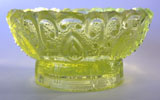 French
Lacy Salt, circa 1840-1845, extremely rare in this color, maker unknown.
French
Lacy Salt, circa 1840-1845, extremely rare in this color, maker unknown.
- Gibson
Glass:
Charles Gibson started a small cottage industry glass shop in
Milton, WV in approximately 1982. He had previously worked at Blenko
Glass and also Biscoff Glass prior to starting his own shop. His
specialities were paperweights, carnival glass and a line of fancy
marbles. He also
made some very nice vaseline glass with heavy opalescence. They made
limited
edition cruets, lady's spittoons and perfume bottles (usually dated).
Gibson also made the first convention piece for VGCI and it was the
first 'marked' piece the club had made. It was a bulbous vase
made into a spittoon shape. This art glass egg-shaped paperweight
is made of vaseline glass with a feathering of an opaque layer of
amethyst glass. The entire piece was then iridescent carnival
finish, to give it a shimmery effect. It is marked and dated on the
underside: GIBSON 2001.
The 10 Gallon hat was also made by Gibson. A store clerk at
Gibson's
factory
confirmed that it was made "in the late 1990's" and "Charlie made about
2 dozen." It is unmarked and crackle glass. Detail includes
a hat band. The factory closed in 2005, due to the failing health
of Mr. Gibson.
 Vaseline carnival egg with amethyst
feathered pattern, 2001.
Vaseline carnival egg with amethyst
feathered pattern, 2001.
 Unmarked
Gibson "10 Gallon Hat" in crackle glass.
Unmarked
Gibson "10 Gallon Hat" in crackle glass.
- Gillinder
& Sons: Started in 1861 in Philadelpia, PA in 1861 and moved to
Greensburg, PA in 1888. They joined the US Glass Co. as 'Factory G' in
1891. This company still operates today as Gillinder Glass in Port
Jervis,
NY (at the crossroads where PA, NY, and NJ meet). One of their more
collectable
patterns was called "Leaf" by the factory, but has since become known
as
"Maple Leaf". Maple Leaf was made in the 1870's and the most famous
piece
of this set is the 'Grant Peace Plate' that has the Maple Leaf border
with
the image of General Grant in the center and inscribed "LET US HAVE
PEACE,
U.S. GRANT". The Maple Leaf pattern comes in a variety of colors and
items,
including full table settings. Pictured here are the 13" platter, the
small
open dishes (on three feet) and a large oval bowl. Gillinder
continued
to make glass and during the 1930's, they made the Buddha shown
here.
Cambridge also made one during this same time period. The
Gillinder
one does not have a topknot or earrings, which are present on the
Cambridge
version.
 Partial
place setting of "Maple Leaf" by Gillinder & Sons.
Partial
place setting of "Maple Leaf" by Gillinder & Sons.
 Gillinder
BUDDHA, circa 1930's. (the stand is not part of the original Buddha)
Gillinder
BUDDHA, circa 1930's. (the stand is not part of the original Buddha)
- Greener
& Co. : Henry Greener was the force behind the Wear Flint Glass
Works in Sunderland, Great Britian. They made a wide variety of
glass
goods and were direct competitors of both Davidson and Sowerby.
Greener
died in 1882, but his company continued under that name. In 1886,
Jobling bought out the struggling company, but it continued with the
Greener
name and reputation to well into the 20th century. The factory
subsequently
changed it's name to Jobling. This rare basket with the rustic
handles
was made by Greener. The handles themselves give us the date, as
they were a registered design on March 27, 1888. This unmarked
piece
was given a registration number (for the rustic handles only) of Rd.
#96775.
 Greener
was given a registration number for these rustic twig handles on March
27, 1888. The piece is unmarked.
Greener
was given a registration number for these rustic twig handles on March
27, 1888. The piece is unmarked.
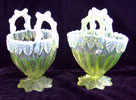 These two baskets were made from the same
mold as the one shown above.
These two baskets were made from the same
mold as the one shown above.
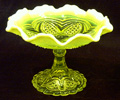 This pattern was registered on Sept. 3,
1997 and is marked Rd. 304505.
This pattern was registered on Sept. 3,
1997 and is marked Rd. 304505.
 This pattern was registered on Oct. 31,
1907 and is Rd. 514796.
This pattern was registered on Oct. 31,
1907 and is Rd. 514796.
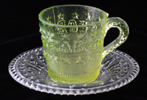 This commemorative cup and Saucer was made
a month after the death of George Peabody (full story in linked photo).
This commemorative cup and Saucer was made
a month after the death of George Peabody (full story in linked photo).
- Heisey:
First produced vaseline 1899-1900. Tried experimental pieces about
1923-24.
Very rare, very expensive. The first item pictured is called 'Pineapple
and Fan', Heisey's pattern no. 1255. It is extremely rare in
Vaseline
and even more so to have an opalescent rim. The second photo is
'Winged
Scroll' (Heisey's pattern no. 1280), also in the same category of
rarity.
Most Heisey experts have never seen these! My thanks to Doug Sandeman
for
allowing me to share these two ultra-rare items with you!
 "Pineapple
& Fan" Canary Opalescent, by Heisey
"Pineapple
& Fan" Canary Opalescent, by Heisey
 "Winged
Scroll" Nappy, by Heisey
"Winged
Scroll" Nappy, by Heisey
- Hobbs,
Brockunier
& Co.: Formed in 1863. Located in Wheeling, WV. In 1864,
William
Leighton, Sr. developed and perfected a lime glass formula that could
be
worked in a mechanical press. Reorganized in 1888 as Hobbs Glass Co.,
became
factory 'H' in the US Glass Co in 1891. These two glasses, originally
called No.
323 Dew Drop, is now called by it's more popular name of 'Hobnail'.
These two are called Rubina Verde (literally: Red Green) and Canary
Opalescent.
Rubina Verde differs from other ruby or cranberry glass, in that it is
made from vaseline glass and stained red. Both of these have the
polished
'punty' on the bottom. The rare Maltese and Ribbon celery vase at
the bottom is rare in any color. It was originally called pattern
"No. 102". The bottom photo shows a rare No. 1706 Dew Drop Rubina
Verde Opalescent lampshade in a vintage electrified (converted from
oil) lamp. The shades were made with 4" and 5" fitters. The
one shown is a 5" fitter.
 Two
'Hobnail' tumblers from Hobbs, Brockunier & Co.
Two
'Hobnail' tumblers from Hobbs, Brockunier & Co.
 A
Hobbs Toy Tumbler and Toy Lemonade Pitcher. The tumblers were
also sold as toothpick holders.
A
Hobbs Toy Tumbler and Toy Lemonade Pitcher. The tumblers were
also sold as toothpick holders.
 A
Hobbs MALTESE & RIBBON celery vase in rare vaseline.
A
Hobbs MALTESE & RIBBON celery vase in rare vaseline.
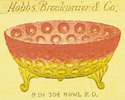 An 8" diameter POLKA DOT Rubina
Verde bowl, circa 1884.
An 8" diameter POLKA DOT Rubina
Verde bowl, circa 1884.
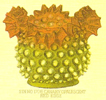 This is shape No. 1706, Dew Drop lampshade
in Rubina Verde Opalescent, with vintage lamp, circa 1886.
This is shape No. 1706, Dew Drop lampshade
in Rubina Verde Opalescent, with vintage lamp, circa 1886.
- Hoffman:
Heinrich Hoffman lived from 1875-1939. At the turn of the 20th
century,
he had an artist's studio in Paris, where he made glass molds.
The
molds were then sent to Bohemia, where his wife, Josephine, was in
charge
of making the glass. Hoffman's trademark was a small, open-winged
butterfly that is frequently (but not always) on his glass. Some
of the toughest pieces of Hoffman to find are those made from vaseline
glass. Some of Hoffman's molds are being used today by
Desna.
One in particular is the nude woman, sitting on the edge of a tub with
her legs straight in front of her. The original Hoffman piece has
a butterfly mark on it. The Desna piece is missing this
mark.
In the enlarged photo below, the butterfly is at the bottom center of
the
piece and has been enlarged to show detail in the right hand corner.
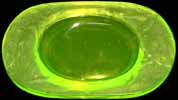 Hoffman
trinket or soap dish, Art Deco Period (1920's)
Hoffman
trinket or soap dish, Art Deco Period (1920's)
- Imperial
Glass Co.: Their color was called 'golden green' and they were
organized
in Wheeling, WV, in 1901. Imperial producing glass in Bellaire, OH, in
1904. They were primarily noted for carnival and stretch glass and were
one of the three main producers of stretch glass in the US. This
rare covered candy dish on high standard is simply known as pattern
#78.
It is rarely found in vaseline glass. The bottom photo is of a
mayo
bowl and saucer. They were shown in a very early Imperial catalog
(No. 201 - circa 1926) and that catalog mentioned that there were six
dozen
sets packed per barrel. This is not the same color as Imperial's
post-1959 vaseline glass. The bowl and the underplate were made
from
the same mould and the plate was flattened while the glass was still
soft.
It does not fit squarely on the bottom. Imperial added a glass
ladle
and sold the three pieces as a Mayonnaise set. Collectors
frequently
refer to this pattern as "Star Spray", but it was not named this by
Imperial. NOTE:
Imperial was also the manufacturer of the various pieces marked MMA
(Metropolitan
Museum of Art) during the mid-1970's, which was giftware for MMA.
Click on the bottom photo of the 'boat' to see an original ad.
All
pieces by MMA are marked. They made a Peacock platter, dolphin
candlesticks,
an open salt, this yacht, and others. The ad is courtesy of an
old
MMA Christmas catalog from the mid-1970's.
 Imperial
#78, high standard candy dish with lace trim, circa 1960's -
1970's.
Imperial
#78, high standard candy dish with lace trim, circa 1960's -
1970's.
 "Star
Spray" (OMN No. 629B) Mayonnaise set, c. 1926, Imperial Glass Co.
"Star
Spray" (OMN No. 629B) Mayonnaise set, c. 1926, Imperial Glass Co.
 MMA
(marked) repro of old Hobbs boat, Imperial, c. 1975
MMA
(marked) repro of old Hobbs boat, Imperial, c. 1975
- Indiana
Tumbler & Goblet Co: Started in 1899, destroyed by fire 1903.
More
commonly known as Greentown Glass. One of their more famous pieces was
the Dewey pattern. Shown here is a picture of the full-sized creamer in
this pattern. One of the novelty pieces that Greentown made was
this
little 'dustpan'. When found, these little dustpans usually have a
'chipped'
front lip or it has been ground by a repairperson. This is due to the
way
it was made: Two of them were in the mold, each piece facing each other
at this front lip (like a open book). The glass worker would
'snap'
the two pieces apart. If you find one of these, don't pass it up
because of nicks on the front lip!
 "Toy
dustpan" by Indiana Tumbler & Goblet Co.
"Toy
dustpan" by Indiana Tumbler & Goblet Co.
- Jefferson
Glass Co.: Founded in Steubenville, OH, in 1900. Relocated to
Follansbee,
WV in 1906. Also had a plant in Canada. Makers of some very nice
opalescent
vaseline glass. Made "Iris with Meander" pattern (see pic). For more
information
about Jefferson Glass Co., please refer to the January 1999 copy (Vol.
1, #2) of GLOWING REPORT. Click on the ad below to see a large
grouping of this pattern.
 1907
ad showing Iris w/ Meander toothpick. Note price!
1907
ad showing Iris w/ Meander toothpick. Note price!
 Swag
& Brackets & Iris: the only 2 Jefferson TP's made in vaseline!
Swag
& Brackets & Iris: the only 2 Jefferson TP's made in vaseline!
- Karg:
Rollin Karg is an independent, contemporary glass blower who has a
studio
in Kechi, Kansas. Each piece made is unique. His background
includes
engineer, turned photographer, turned potter, turned woodworker, turned
glassblower. At a streetfair in OKC in 1999, I approached Rollin
and asked him if he had ever worked with vaseline glass and he said he
knew of it, but had not. I sent a piece of cullet with him and he
created five paperweights, each were different. The cullet,
having
come from Fenton, made the vaseline stripes turn into white opalescent
swirls. Under a blacklight, it glows! He also swirled in
some
cranberry glass into this particular paperweight. For more on
marbles
and paperweights, click HERE!
 Rollin
Karg original paperweight, 1999
Rollin
Karg original paperweight, 1999
- Kemple
Glass
Works: The Kemple Glass Works was started in 1945 by John
Kemple
of East Palestine, Ohio and closed in 1970 when Mr. Kemple died.
In 1953-54, Kemple acquired a lot of molds that had previously belonged
to the McKee Glass Co. Many of these were the "-TEC" series of
patterns
that McKee had made. This bowl was originally called "YUTEC" by
McKee.
Kemple was known for making "authentic reproductions", which is a
politically-correct
term for 'repro'. You can see another piece in this pattern in
the
Glickman/Fedosky book on vaseline glass as item #411.
 "Yutec"
reproduction by Kemple Glass Co., c. mid 1960's.
"Yutec"
reproduction by Kemple Glass Co., c. mid 1960's.
- King
Glass
Co. originated in Pittsburgh, PA in 1869 and in 8/1888, bought out the
old McKee factory in Pittsburgh. In 8/1891, they joined the U.S.
Glass Co. combine and became Factory 'K'. They continued to make
glass into the 1930's before USGC phased out their site due to low
profits.
This salt shaker has been attributed to King Glass. This may have
occurred before or during their time with USGC. It resembles an
old
vertical stove. It was also made in blue, amber and clear.
The second photo shows the JOCKEY butter dish in a rare vaseline
color. The horizontal ridges going down the front of the lid are
the same design that King used for the Helmet butter. Both butter
dishes also used a daisy and button pattern. No original catalog
illustrations exist for the JOCKEY butter. The Helmet butter and
the SPICE BARREL are both shown in an old King Glass catalog, and the
notation is written that those two were made in 'flint, blue and
amber'. The SPICE BARREL is shown in vaseline glass in Glickman's
YELLOW-GREEN VASELINE book as color photo #63. The last photo is
the No. 308 BRACKET SOAP dish, which is shown in an old King Glass
Catalog. A No. 309 Slab Soap may also exist, but has not yet been
photographed in vaseline glass.
 King
Glass Co, "stove" salt shaker, four inches tall.
King
Glass Co, "stove" salt shaker, four inches tall.
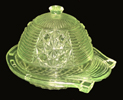 JOCKEY butter, attributed to King Glass
due to similarity to the HELMET butter design
JOCKEY butter, attributed to King Glass
due to similarity to the HELMET butter design
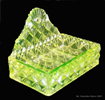 NO. 308 BRACKET SOAP dish by King Glass,
circa 1880's.
NO. 308 BRACKET SOAP dish by King Glass,
circa 1880's.
- Jack
Loranger: Jack is
a contemporary artist who
runs a one-man shop in Washougal, Washington, just north of the
Columbia river gorge. He is making a name for himself with the
vaseline glass collectors and is willing to take on custom
orders! The webmaster for VGCI recently got to visit Jack's shop
and had the opportunity to blow a piece of glass! Here is a link
to the whole story: CLICK HERE.
Jack also has a WEBPAGE where you
can see some of his items. He does not keep a lot of glass in
inventory (it sells too quickly!), so if you see something you like,
order it and he will get on it right away!
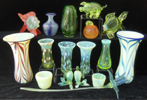 A
grouping of glass made by Jack Loranger during the past few years.
A
grouping of glass made by Jack Loranger during the past few years.
- McKee
and
Brothers: originated in Pittsburgh, PA, in 1853. In 1888, it moved
to a Pennsylvania community which became known as Jeanette. McKee was
noted
for its' clocks, dispensers, lamps, and crackleglass. After several
name
changes, it was purchased by the Jeanette Glass Corporation in 1961.
The
"Queen" pattern (also known as 'pointed panel' or 'panelled daisy &
button' or 'sunk') was made by McKee in 1894. The example shown is an
original
spooner. This pattern is being reproduced today in three items:
compote,
pedestal cakeplate, and covered butter (see "Mosser", listed
below). The
water pitcher and tumbler are also now being reproduced.
 Spooner
in "Queen" pattern by McKee and Brothers, 1894.
Spooner
in "Queen" pattern by McKee and Brothers, 1894.
- Millersburg
Glass Co.: The Millersburg Glass factory was opened in 1909 by John
Fenton, who had resigned from the Fenton Glass Co. to start this
firm.
Within 4 months, they were into financial trouble and people who
supplied
their molds were seeking court assistance to get their payments.
By 1911, the factory was closed. They specialized in carnival
glass,
which was the rage of the day. Pictured below is an Acorn
compote,
one of only a very few known to exist (probably less than five).
Bottom photo is a GRAPE LEAVES bowl in vaseline carnival glass.
 "Acorn"
carnival and vaseline compote, made by Millersburg Glass Co.
"Acorn"
carnival and vaseline compote, made by Millersburg Glass Co.
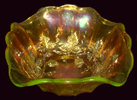 "Grape Leaves" carnival vaseline
bowl,
made by Millersburg Glass Co.
"Grape Leaves" carnival vaseline
bowl,
made by Millersburg Glass Co.
- Mosser
Glass,
Inc.: Founded in 1964 in Cambridge, OH, and known for making
reproduction
and novelty pieces. Has recently come out with "Queen" pattern covered
butter dish, pedestal compote and pedestal cake plate. These are not
marked
as reproductions. The glass is a lot brighter than the original "Queen"
pattern that was quite pale, but had a terrific florescent glow to
it.
Shown in the photo below is one of their first ventures into opalescent
glass, an acorn and leaf spooner, marketed throught Rosso.
 Mosser
ACORN & LEAF spooner, made in 2001.
Mosser
ACORN & LEAF spooner, made in 2001.
- National
Glass: A conglomerate of 19 early glass factories that was formed
when
Wall Street started getting rough. Some of the more notable companies
in
this group were Indiana Tumbler (Greentown), Model Flint Glass (Albany,
Indiana), McKee & Bros., Northwood Glass Works & Riverside
Glass
Works. The 'Wreath & Shell' pattern (shown below) was made for less
than three years. This pattern was originally called 'Manila' by Model
Flint Glass (also known as 'Albany Glass'). The 'Garland of
Roses'
dish might be the base to a butter dish. Any piece in this
pattern
is very scarce in canary.
 Ladies
Spittoon, 'WREATH & SHELL' pattern from Model Flint Glass (Nat'l
Glass).
Ladies
Spittoon, 'WREATH & SHELL' pattern from Model Flint Glass (Nat'l
Glass).
 GARLAND
OF ROSES dish by one of the National Glass Co. factories.
GARLAND
OF ROSES dish by one of the National Glass Co. factories.
- Northwood
& Co.: Harry Northwood established his company in Wheeling, WV.
He had previously run glass factories in Indiana, Pennsylvania, and
elsewhere. As Northwood made so much vaseline glass, only very
special pieces are shown here. The first listing is for the
Bon-Bon in the GRAPE pattern. The GRAPE pattern is widely known
in a variety of shapes for carnival glass collectors. The bon-bon
was also made in vaseline opalescent (and no other opalescent
color). The bon-bon was pressed on the outside with Northwood's
basketweave pattern. The
butter
dish (below) is the "MEMPHIS" pattern (c. 1908) and is very rare in
this
color. The third photo is of the pattern originally called
DIADEM,
more popularly called "SUNBURST-ON-SHIELD." This rare platter was
made by flattening out the master berry bowl. The fourth photo
shows an extremely rare, possibly one-of-a-kind test piece! It is
MIKADO. This pattern was only made in opalescent glass in the
nappy shape. All references books only list it in the opalescent
colors of flint (clear), blue and green. This is a vaseline
version. Additionally, it also has a different pattern
(Northwood's POPPY) pressed on the inside
of the bowl! To make it even more unusual, the bottom foot has a
full flower pressed onto the bottom! All other versions (clear,
blue, green) only have a pattern on the outside of the bowl and a
standard star pattern on the bottom of the foot. It was difficult
to show the pattern on the inside of the bowl, so a piece of foil was
rubbed over the pattern to show the relief. Dave Doty also shows
this on his website
as LIGHTNING FLOWER in carnival glass. The carnival glass version
has the same pattern on the inside and the outside. The enlarged
photo
shows all of the features mentioned.
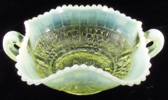 Northwood
GRAPE
bon-bon (aka: Grape and Cable), circa 1910-15.
Northwood
GRAPE
bon-bon (aka: Grape and Cable), circa 1910-15.
 MEMPHIS butter dish by Northwood.
MEMPHIS butter dish by Northwood.
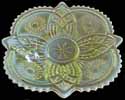 SUNBURST-ON-SHIELD (DIADEM)
whimsey platter, circa 1905.
SUNBURST-ON-SHIELD (DIADEM)
whimsey platter, circa 1905.
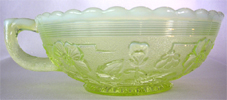 MIKADO nappy, with internal pattern
and flower pattern on base, circa 1905
MIKADO nappy, with internal pattern
and flower pattern on base, circa 1905
- O'Hara
Glass
Co.: The O'Hara Glass Company of Pittsburgh, PA, was another
company that joined the U. S. Glass Co. combine in 1891. There
are
only three patterns currently known that was made by this firm: "Block
& Panel," "Column Block," and "Reticulated Cord." The
"Reticulated
Cord" pattern is also known as "Cable" and reminds one of the lacings
on
an old drum. This pattern was made in a full range of
dishes.
It is unknown if all pieces were made in vaseline. the compote is
was not previously listed in any reference book and is an unlisted
shape. The COLUMN BLOCK castor set (consisting of Oil bottle with
stopper, mustard, salt & pepper + frame) usually came with each
piece being a different color: clear, blue, amber, and
canary. This set was assembled over a period of years. A
vaseline glass base is still being sought. All bottles except the
oil are interchangable.
 "RETICULATED
CORD" compote by O'Hara Glass Co.
"RETICULATED
CORD" compote by O'Hara Glass Co.
 COLUMN BLOCK castor set in vaseline
with glass amber foot and metal peg-style handle.
COLUMN BLOCK castor set in vaseline
with glass amber foot and metal peg-style handle.
- Pairpoint
Mfg. Co.: Started in 1880 in New Bedford, Mass. Merged with Mt.
Washington
Glass in 1894. After several name changes and ownerships, it relocated
to E. Wareham, Mass., in 1957 and became Pairpoint Glass Co., importing
spanish glass. Factory was reopened in Sagamore, Mass. in 1970. Famous
for the clear 'controlled bubble' ball on the pedestal base, usually
with
colored glass above and below. Their name for vaseline was 'canaria'.
The
glass is very fine art glass, hand blown, high lead content (rings when
'flicked'), and a beautifully polished pontil. One of the highest
quality
pieces of vaseline made and quite scarce to locate at any price.
Canaria
was made for only a few years in the 1920's. For more information about
Pairpoint Mfg. Co., please refer to the November, 1998 copy (Vol. 1,
#1)
of the VGCI club newsletter.
 CANARIA
"Colias" cut/engraved pattern/sterling silver base, by Pairpoint.
CANARIA
"Colias" cut/engraved pattern/sterling silver base, by Pairpoint.
- Pilgrim
Glass Corp.: This company was founded by Alfred E. Knobler in
Ceredo, WV. The glass made at this factory is done in the
old-fashioned
way, by hand and blown. Crackle glass is a specialty of theirs.
Pilgrim
made some vaseline glass in the 1970's (small vases, creamers, sugars,
etc.). They also made this small vaseline (with clear handle)
creamer
in the 'Bennington' pattern. This exact mould was used to make
various
colored and clear glass creamers for the Metropolitian Museum of
Art.
This pattern was shown as one of the offerings in their Christmas
catalog
for 1977 (in clear glass). The sugar bowl is in the shape of a
top
hat. This blown glass creamer has a pontil on the bottom.
It
mimics glass made by the Boston & Sandwich Glass Co. This
mould
has since been purchased by Gibson Glass and they are making a variety
of items from the mould.
 Creamer
made by the Pilgrim Glass Co., c. 1970's.
Creamer
made by the Pilgrim Glass Co., c. 1970's.
- Richards
& Hartley: Founded in Pittsburgh, PA in 1869. Noted for pressed
wares and some very nice blown glass epergnes. Became part of US Glass
in 1891, closed in 1893. Richards & Hartley also made a few
victorian
novelties. Seen below is (original name) CAT, but more commonly known
as
'Kitten on Pillow" toothpick holder. When Richards & Hartley joined
U.S. Glass in 1891, production was continued for a short period of
time.
Original colors are clear, blue, canary, and amber. This item has been
reproduced by Boyd and possibly by others (based on examples I have
seen
in dark green, medium blue, and a light pink). See GLOWING REPORT, vol.
1, #4 to learn about the differences. It has not yet been reported that
it has been reproduced in vaseline glass. It is found frequently on
internet
auctions as 'otter on pillow'. The Pickle castor shown is the
GRACE
pattern and is illustrated in "Victorian Colored Pattern Glass, Book 5:
U.S. Glass From A-Z" (Heacock/Bickenheuser) on pg. 118, plate A.
The pattern was also called "ORIENTAL" by Ruth Webb Lee in "Victorian
Glass".
Each piece of the pattern has a different design and it is a real
hodge-podge
grouping. This pattern was a response by Richards & Hartley
to
Duncan's "JAPANESE" pattern, which is often confused with this
pattern. The last photo shows a CUPID & VENUS (Original name:
Pattern #500) milk pitcher.
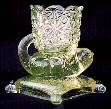 "Kitten
on Pillow" toothpick holder by Richards & Hartley.
"Kitten
on Pillow" toothpick holder by Richards & Hartley.
 "GRACE"
pickle castor (also known as ORIENTAL), circa 1881, continued by U.S.
Glass
Co. after 1891
"GRACE"
pickle castor (also known as ORIENTAL), circa 1881, continued by U.S.
Glass
Co. after 1891
 CUPID & VENUS milk pitcher, circa 1875.
CUPID & VENUS milk pitcher, circa 1875.
- W.
H., B
& J Richardson: This firm in the Stourbridge area of
England
started out as Richardson and Webb in 1825. Thomas Webb went his
own way in 1836 and the firm became known by this name. They were
known for fancy art glass, 'friggers' (the British term for
'whimsey').
Tulips were one of their favorite shapes and glass feet were common in
this particular area of glassmaking in England. While
identification
can never be positive, these two posey vases are attributed to the
Richardson
glassworks. Note the small amount of uranium used, which was
common
for Richardson. These two pieces date to about 1900. The
novelty Crocodile in the bottom photo was made using a hand mold.
It's only intended use was as a novelty. The tail was 'pulled'
while the glass was still hot. It ia about 5 inches long.
 Two
Posey vases attributed to Richardson, Stourbridge region of England.
Two
Posey vases attributed to Richardson, Stourbridge region of England.
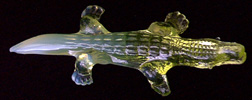 Crocodile novelty, circa 1890.
Crocodile novelty, circa 1890.
- Ripley
&
Co. (factory 'F', US Glass Co. combine: Daniel Ripley, Jr.,
was
the son of a great glass maker and grew up in the glass business.
In 1870, Ripley, Sr., passed away. In 1875, Ripley & Co.
started
a new factory, also in Pittsburgh, PA. Ripley was the last glass
factory to succumb to the "colored glass" rage and started making
colored
glass in 1884. In 1891, Ripley joined U. S. Glass Co. and became
their President. The central office for U. S. Glass was the
Ripley
factory. In 1909, Ripley resigned from U. S. Glass and started a
new factory in Connellsville, PA. U. S. Glass continued to use
the
old Ripley factory in Pittsburgh for their central office until 1937,
when
they moved to Tiffin, OH. This little child's plate (7" in
diameter)
was useful to teach children their alphabet, roman numerals,and
time.
It also has a conversion on it for military time, listing the numbers
13
- 24 above the roman numerals. The child's cup and saucer was
originally
called "No. 175 Toy Cup and Saucer." The generic name has become
"Cat on a Cushion" Toy cup and saucer. The cup is 2" tall.
On the opposite side of the cat the cup shows a dog, running in a
field,
with a fence behind him. The center of the saucer shows a cat
with
its' head sticking out of the top of a tall boot. This piece is
very
rare in vaseline glass! Click on the small photo to see both
sides
of the cup and the front of the saucer.
 CLOCK
w/ SCALLOPED EDGE, (USGC factory 'F', Ripley), c. 1890's.
CLOCK
w/ SCALLOPED EDGE, (USGC factory 'F', Ripley), c. 1890's.
 CAT
ON A CUSHION toy cup and saucer, Ripley Glass, prior to 1891, and US
Glass
after 1891.
CAT
ON A CUSHION toy cup and saucer, Ripley Glass, prior to 1891, and US
Glass
after 1891.
- Riverside
Glass Works: Operated in 1880 in Wellsburg, WV. Noted vaseline
patterns
are Petticoat, Ranson, Derby, National Star and Duchess. All five
patterns
were designed by Riverside, but Ranson was actually produced in
vaseline
by Beaumont Glass, across the river at Martins Ferry, OH. The other
four
were made in vaseline by Riverside at the Wellsburg location. Factory
closed
in 1907. Riverside's Croesus was never made in vaseline, but is being
reproduced
today using new molds, with the quality being less than the original
pressings.
For more information about Riverside Glass Works, please refer to the
November,
1998 copy (Vol. 1, #1) of the VGCI club newsletter.
 National
Star covered sugar bowl, with Ruby casing, by Riverside Glass Co.
National
Star covered sugar bowl, with Ruby casing, by Riverside Glass Co.
- Rosso:Technically
not glass manufacturers, but are worth mentioning here. Helen &
Phil
Rosso are glass wholesalers who contract with various glass companies
that
currently make vaseline glass (such as Fenton) and have exclusive
pieces
made for sole distribution by them. For example, Rosso may have an
exclusive
piece that comes from Fenton, complete with Fenton logos, but a
collector
could only buy it through Rosso's. To read an article about Rosso
Wholesale
Glass Dealers, Inc., that ran in the GLOWING REPORT (Vol. 1, #3),
please click HERE.
- Schmid Verriers at
Vannes-le-Chatel: There have been numerous pieces of
vaseline glass that have been found through the years with the marking
of 'SV' embossed on the piece. There has also been the
speculation that these pieces were made by Vallerysthal or
Portieux. Due to research done by Shirley Smith (Hen-on-Nest
expert) and Siegmar Geiselberger (Pressglass-Korrespondenz), we now
know that this piece was made by Schmid Verriers. The
glassworks was orignally formed in 1765 by Comtess de Mazirot,
and then established by the Schmid family in 1823. The Schmid
family owned and operated the company until 1970., when it merged with
Vallerysthal Portieux and Bayel and Fain. The company now markets
their glass under the name of 'Cristal de Sevres' (Vannes French
Crystal Company or initials 'CFC'). Daum incorpartes the
company and is also known as DAUM-CFC. Up until
1859, wood was used to fire the furnaces. Coal was used from 1860
to 1940. From 1940-1945, there was no production, due to lack of
workers, who were all in captivity, and the lack of coal, due to the
war needs. The factory archives were also destroyed in
1940. From 1945-1946, Coal was used again for the furnaces.
In 1946, the transition was made to natural gas and
electricity. In 1979, continuous melt furnaces were
introduced. In 1840, the factory employed 340 workers, and
in 1960, the total work force was 680. Between 1962 and 1964, a
gradual transition was made to crystal glassware. The factory is
still operating today. For the original article by Shirley Smith
and Siegmar Geiselberger, please click on this LINK.
 'WOODEN ICE
BUCKET' by Schmid Verriers at Vannes-le-Chatel, circa unknown, but
before 1962.
'WOODEN ICE
BUCKET' by Schmid Verriers at Vannes-le-Chatel, circa unknown, but
before 1962.
- L.E.
Smith
Co.: Located in Mt. Pleasant, Penn. Canary was first made in 1926.
Makers of crackle glass and pattern glass. "By Cracky" was made during
the depression years by this company and is a pattern glass made to
resemble
the old 'Tree of Life' pattern. The company continues to operate under
new ownership.
 "BY CRACKY" sherbet and underplate, by L. E. Smith.
"BY CRACKY" sherbet and underplate, by L. E. Smith.
- Steuben
Glass: Frederick
Carder started Steuben Glass in 1903, along with T. G.
Hawkes. Carder was in complete control of glass formulas and
designs until 1932, when the company's management went to Corning Glass
Works. Carder made three shades of yellow glass that will glow:
Citron, Jade Yellow, and Bristol. The first photo shows examples
of all three colors. Carder also did detailed drawings of all of
his designs and Steuben collectors refer to those design numbers
instead of pattern names. The candlesticks shown in the bottom
photo are design number 686/color citron. Design 686 was made in
three heights. This is the middle size, measuring 10" in height
with a 4.5" base. 99% of the glass made by Carder during this
time was leaded glass (there were 2 colors that could not be made with
lead oxide). All of the glass was made by hand and no mold work
was used. ANY Steuben glass carries a high price tag.
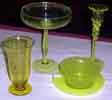 Steuben vaseline glass: Bristol,
Citron, Jade Yellow.
Steuben vaseline glass: Bristol,
Citron, Jade Yellow.
 Steuben #686 candlesticks in
Citron Yellow.
Steuben #686 candlesticks in
Citron Yellow.
- Stevens
& Williams: Stevens & Williams of Stourbridge,
England, made
many types of glass, including layered, etched, cameo, and art glass,
between
the 1830s and 1930s. Some pieces are signed S & W. Many pieces are
decorated with flowers, leaves, and other designs based on
nature.
One of the items that many English glass houses were known for were 'whimseys'
(known in England as 'friggers'). These two terms have taken on
the meaning of a glassmaker playing about with making small articles
for
himself on his own time. Throughout the history of glassmaking,
the
glassmaker has relieved the tedium of production by creating a charming
variety of glass novelties. Pictured here is a bugle. It
has
also been referred to as a 'stick vase'. Glassmakers during the
time
were known for holding parades and there are numerous references of
glass
bugles or trumpets used in these processions due to the "sweetness and
correctness of tone". This particular bugle/stick vase is
attributed
to Stevens & Williams. It has a beautiful bell-tone when
flicked.
It also shows some opalescent qualities and yes, it can function as a
horn. A design that was unique to Stevens & Williams was
ARBORESQUE and is a crackle effect that is internal. This style
came in a lot of shapes and at least 4 different colors. This
version is vaseline with blue accents and handles.
 Whimsey
horn attributed to Stevens & Williams. It will play, and can
also be used as a bud vase!
Whimsey
horn attributed to Stevens & Williams. It will play, and can
also be used as a bud vase!
 ARBORESQUE by Stevens & Williams,
circa 1930.
ARBORESQUE by Stevens & Williams,
circa 1930.
- Summit:
Founded in Akron, OH in 1972. Moved to Rootstown, OH, in 1984. Still in
operation. Purchased many of its molds from the St. Clair Glass works.
Has made every imaginable color combination of the "Joe St. Clair"
Indian
Head toothpick holder. They also makes new vaseline glass of old
patterns.
Summit marks some of their glass with a 'V' inside of a circle.
This
photo shows a glass pistol in the foreground and a double pistol with
fount
attached in the background. There was only 50 of these made with
the fount still attached. They were sold by Rosso Wholesale Glass
Dealers, Inc. All of the ones made by Summit are rough-ground
where
the gun butt attached to the fount. These were never made
originally
in vaseline glass and all found are reproductions. Over 400 of
the
single pistols have been sold by Rosso as of 1/2002.
 Double
pistols with fount attached and single pistol in foreground, Summit,
2001.
Double
pistols with fount attached and single pistol in foreground, Summit,
2001.
- U.S.
Glass:
Conglomerate of 18 glass manufacturers formed in 1891. Notable
companies
included: Adams & Co., Bryce Bros., Geo. Duncan & Sons,
Richards
& Hartley, Central Glass Co., AJ Beatty & Sons, and Novelty
Glass
Co. Among other patterns, they made this example of "Palm Beach"
pattern.
The vaseline glass in the palm beach pattern is very bright, almost
like
the contempory glass being made today, but was made after 1906. I have
not been able to discover which of the 18 factories made the "Palm
Beach"
pattern. This combine continued as Tiffin Glass in later years.
 PALM
BEACH berry bowl by U.S. Glass Co.
PALM
BEACH berry bowl by U.S. Glass Co.
 MEDALLION
goblet, by one of the factories of U.S. GLASS CO. combine.
MEDALLION
goblet, by one of the factories of U.S. GLASS CO. combine.
- Vallerysthal:
This is another French glass house, which has made some very nice
vaseline
glass around the turn of the century. This particular covered
dish,
called "Artichoke" is flint glass and was made between 1908-1910.
It appears in a Vallerystahl text in milk glass during this time frame
is about the limit of the information available. The following
information
comes from "Yesterday's
Milk Glass Today" by Regis F Ferson & Mary F Ferson, 1981, Self
Published,
Pittsburgh, page 159: The Vallerysthal glass
Company
operated two factories in France: one at Portieux in a section
known
as Vosges and one at Vallerysthal in the Lorraine region.
Although
the firm exported glass to the United States from about 1849, milk
glass
in significant amounts was included in the export picture only from
1870
until the centuries old factory was destroyed in World War II.
Shipments
to the United states continued throughout the period between 1870 and
1914
while Vallerysthal glass works, like other concerns in Lorraine and
nearby
industrial centers, was under German control resulting from the
Franco-Prussian
War. It was not returned to France until new territorial divisions
were established after World War I. While the subject is
not
milk glass on this resource page, it gives the reader some insight on
the
company.
 ARTICHOKE
covered sugar by Vallerysthal, in pressed flint glass, c.
1908-1910.
ARTICHOKE
covered sugar by Vallerysthal, in pressed flint glass, c.
1908-1910.
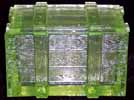 CRATE
by Vallerysthal, with separate lid, circa early 1900's.
CRATE
by Vallerysthal, with separate lid, circa early 1900's.
 FLY
ON WALNUT covered sugar, circa early 1900's.
FLY
ON WALNUT covered sugar, circa early 1900's.
 SNAIL ON STRAWBERRY covered sugar, circa
early 1900's.
SNAIL ON STRAWBERRY covered sugar, circa
early 1900's.
- Val
St.
Lambert Crystal Factory: This company was founded on the site of an
old abbey/monastary in Belgium. It has been making fine crystal
ever
since and continues to operate today. They are famous for their
"double
color cut crystal," using two colors and cutting down through one layer
to expose the other layer. The bottom photo shows a three piece
guest
set from the 1920's. It too, is made from leaded, 'crystal' glass
and rings when flicked with a fingernail.
 Double
color cut crystal vase and perfume atomizer, unknown date.
Double
color cut crystal vase and perfume atomizer, unknown date.
 This
monsterous vase is double color cut, ruby to vaseline. The small
salt gives the viewer an idea of the size.
This
monsterous vase is double color cut, ruby to vaseline. The small
salt gives the viewer an idea of the size.
 This
little dresser powder pot is part of a larger dresser set. It is
double
cut,
ruby to vaseline. The finial is clear crystal.
This
little dresser powder pot is part of a larger dresser set. It is
double
cut,
ruby to vaseline. The finial is clear crystal.
 This ring
holder is also a part of the dresser set. The ring is a man's
size 15 ring with cut vaseline glass 'diamond'.
This ring
holder is also a part of the dresser set. The ring is a man's
size 15 ring with cut vaseline glass 'diamond'.
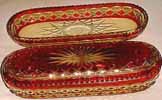 The
back dish is a pin tray, the front dish is a covered tray. Both
are
part of the dresser set.
The
back dish is a pin tray, the front dish is a covered tray. Both
are
part of the dresser set.
 Three
piece guest set. The pattern name for this was recently
discovered: VALAMBERT
Three
piece guest set. The pattern name for this was recently
discovered: VALAMBERT
- John Walsh Walsh:
John Walsh Walsh purchased a glass company in 1850 in Birmingham,
England. His previous business was making soda water and one of
the first registered designs made at his glass factory was a container
for soda water. JWW passed away in 1864 and his will divided
property between his (2nd) wife and the 6 children (3 children from
each of his two marriages). In 1879, John Walsh Walsh (II), the
son from his second marriage died at the age of 28, and the executors
decided to sell. Ellen Eliza (daughter from first marriage)
convinced her husband, Thomas Ferdinand Walker, to buy the
business. Walker hired Lewis John Murray (formerly of Stourbridge
and had experience with Joseph & Edward Webb's business).
Murray became the manager in Sept. 1882. In November, 1897, the pattern
OPALINE BROCADE was illustrated in the POTTERY GAZETTE. (A year
later, Harry Northwood copied the design and sold it under the same
name in the USA. Wm. Heacock erronously named the pattern SPANISH
LACE, but the original name has surfaced from old catalogs). a
design was registered on Jan. 20, 1891 for a new shaped leg for wine
glasses, bent round so as to look like the stem of a flower. This
was later incorporated into other designs made by the company.
The WATER LILY pattern was illustrated in the POTTERY GAZETTE in
August, 1903. VESTA VENETIAN was registered in March 1908, and it
resembled fine, iridescent Venetian threads. The company
was well known for their excellent cuttings and the company survived
until 1951. (Information condensed from: THE GLASS OF JOHN WALSH
WALSH 1850-1951 by Richard Dennis & Eric Reynolds, copyright 1999,
published by Richard Dennis)
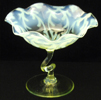 Twisty
stem (reg. 1891) incorporated into OPALINE BROCADE (1897). click image
to see 4 pieces with twisty stems.
Twisty
stem (reg. 1891) incorporated into OPALINE BROCADE (1897). click image
to see 4 pieces with twisty stems.
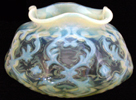 OPALINE
BROCADE, squatty vase, 6.5"
diameter, 4.5" tall.
OPALINE
BROCADE, squatty vase, 6.5"
diameter, 4.5" tall.
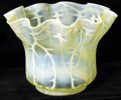 OPALINE
BROCADE lampshade, 4" fitter,
click image for 4 different lighting views.
OPALINE
BROCADE lampshade, 4" fitter,
click image for 4 different lighting views.
 VESTA
VENETIAN small lampshade.
VESTA
VENETIAN small lampshade.
 OPALINE
BROCADE in a 'rubina verde
opalescent' motif (courtesy Bob Harry/Robert Leal).
OPALINE
BROCADE in a 'rubina verde
opalescent' motif (courtesy Bob Harry/Robert Leal).
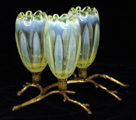 Just
one of many shapes in the WATER LILY
range, circa 1903 (courtesy Bob Harry/Robert Leal)
Just
one of many shapes in the WATER LILY
range, circa 1903 (courtesy Bob Harry/Robert Leal)
- Thomas
Webb
& Sons: Webb and Sons flourished in the Stourbridge
region
of England, specifically Dennis Park. They were known for art glass,
cameo
glass, and cut crystal. The first photo shows
a piece that was made AT Webb, but not BY Webb. In other words,
it
was made by a worker during off hours. It is a true whimsey,
never
being a regular production item. The craftsmanship is all Webb,
with
the spiral twist on the vaseline base, the "raspberry" nodules for feet
and end caps, and the cranberry with opalescent threading around the
neck
of each posey vase. Several art glass experts have all seen this
photo and concur that it could only have been made at Webb for the
listed
reasons, but that it was not a regular production piece and is probably
a unique, 1-of-1 piece. The pieces below are called
LEMONESCENT, which was Webb's trade name for a cranberry vaseline
opalescent combination. Hobbs, Brockunier & Co. had a similar
product, trade name: Rubina Verde Opalescent.
 A
trio grouping of posey vases, all sitting on a vaseline glass
base.
Each vase can be removed. A Unique piece!
A
trio grouping of posey vases, all sitting on a vaseline glass
base.
Each vase can be removed. A Unique piece!
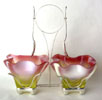 "Lemonescent"
double marmalade. The frame is contemporary, based on the design
of an original single frame.
"Lemonescent"
double marmalade. The frame is contemporary, based on the design
of an original single frame.
 "Lemonescent"
vase with cranberry internal striping. Click on the photo for
additional views.
"Lemonescent"
vase with cranberry internal striping. Click on the photo for
additional views.
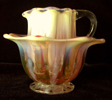 "Lemonescent" creamer and sugar
with cranberry internal striping. Matches the vase above.
"Lemonescent" creamer and sugar
with cranberry internal striping. Matches the vase above.
 This
was a registered design from Thomas
Webbb & Sons. Generically called DRAPES. Circa 1900,
made in a variety of colors & heights.
This
was a registered design from Thomas
Webbb & Sons. Generically called DRAPES. Circa 1900,
made in a variety of colors & heights.
- West
Virginia
Glass Co.: This firm had a rocky history. It started as Elson Glass
Co. in 1882. It became West Virginia Glass Co. in 1893. By
1896, it was reorganized as West Virginia Glass & Mfg. In
1899,
it became one of the factories of the National Glass Co. combine.
By 1903, the doors were shut and all equipment removed. The
building
was later leased to the Fenton Bros., who first set up their glass
decorating
firm (before moving on to glassmaking). This celery vase shown
here
is part of the I.O.U. Pattern (original name: WV #219), named due to
the
pattern vaguely showing these three letters in the pattern. This
one also has gold gilding on it. The pattern was made in 1898,
just
before joining National. It is scarce.
 I.O.U.
Pattern Celery dish with Gold Gilding, West Virginia Glass Co., 1898.
I.O.U.
Pattern Celery dish with Gold Gilding, West Virginia Glass Co., 1898.
- Westmoreland
Glass: Westmoreland Glass made some very nice vaseline glass in
their
history. Although they are more famous for their milk glass, they did
introduce
colored glass (including vaseline) in the 1960's. L.G. Wright had a lot
of glass made for him through the Westmoreland Glass Co. These
two
pieces can be directly attributed to Westmoreland. The vase with
the dolphin feet was made in the early 1940's. The fairy lamp,
with
original paper label, was satinized and decorated (age presumed to be
early
1960's).
 Dolphin-footed
vase, c. 1940's.
Dolphin-footed
vase, c. 1940's.
 Satin
and decorated fairy lamp, with original paper label (bottom right on
foot).
Satin
and decorated fairy lamp, with original paper label (bottom right on
foot).
- Wheaton:
Established in Millville, NJ, in 1888. In the 1970's, Wheatonware sold
some vaseline glass through their home party plan. Kemple molds were
used.
Made a reproduction (but not from original mold) of the Holly toothpick
holder. Greentown Glass never originally made this piece in vaseline
color.
Others have also made the Holly toothpick holder, but not as carefully.
- Whitehurst:
James Whitehurst is an independent glass blower and artist from
Cusseta,
GA. He recently started making vaseline glass in 2000 and has
developed
a following of eager customers. His work was the feature story in
GLOWING REPORT (July, 2001). He sells his glass on the popular
auction
site under the name of blowlava.
 A
Whitehurst Jack-in-the-Pulpit vase, 2001
A
Whitehurst Jack-in-the-Pulpit vase, 2001
 A
Whitehurst Fish vaseline and cobalt goblet, standing 11 inches tall,
2001
A
Whitehurst Fish vaseline and cobalt goblet, standing 11 inches tall,
2001
- L.
G. Wright:
Founded in 1930's in New Martinsville, WV. The company used a variety
of
factories, most notably Fenton, to manufacture glass, which it then
sold.
Other companies to make glass for LG Wright include Gibson, Viking,
Fostoria,
Imperial, Westmoreland, and Summit (all of which have made vaseline for
them). This covered butter dish in the shape of a frog was made
from
an original mold from Bryce, Higbee & Co. that was owned by L. G.
Wright.
'Red' Roetteis, who co-authored the book about L. G. Wright (and was a
former salesman for the company) rented the mold the last week before
the
company closed and had 75 of these butter dishes made. When the
assets
of the company was sold off, the Milk Glass Association purchased the
mold.
 Contemporary
'FROG' butter dish made from an old mold.
Contemporary
'FROG' butter dish made from an old mold.
Click
here to email the Webmaster!
(Credits for photos
are on the
bottom
of the front page)
All images
copyright 2000 - 2004
and cannot be used without written permission from VGCI.

 "No.
2 & No. 3 Gypsy Pots, with lids", Adams & Co., ca 1885-1895.
"No.
2 & No. 3 Gypsy Pots, with lids", Adams & Co., ca 1885-1895.
 Wildflower
Turtle Salt, Adams & Co., c. mid-1880's.
Wildflower
Turtle Salt, Adams & Co., c. mid-1880's.
 ABC/CLOCK
child's plate in 1000 EYE pattern, Adams & Co., mid-1880's.
ABC/CLOCK
child's plate in 1000 EYE pattern, Adams & Co., mid-1880's. GOOD LUCK small wheelbarrow salt or match
safe, Adams & Co., 1882.
GOOD LUCK small wheelbarrow salt or match
safe, Adams & Co., 1882. A rare CHILDREN & A.B.C.D. mug in
vaseline glass, Adams & Co., circa mid-1880's
A rare CHILDREN & A.B.C.D. mug in
vaseline glass, Adams & Co., circa mid-1880's No.
335 1/2, also known as HOBNAIL IN SQUARE by Aetna Glass, introduced in
1886.
No.
335 1/2, also known as HOBNAIL IN SQUARE by Aetna Glass, introduced in
1886.
 Baccarat
open salt (or nut cup), 2.5" diameter X 1.75" tall, c. pre-1900.
Baccarat
open salt (or nut cup), 2.5" diameter X 1.75" tall, c. pre-1900.
 Bayel
Crystal Parrot and Cockatoo - age unknown, but contemporary.
Bayel
Crystal Parrot and Cockatoo - age unknown, but contemporary.
 Over
All Hobs footed spooner by A.J. Beatty & Co.
Over
All Hobs footed spooner by A.J. Beatty & Co.
 "Beaumont's
Columbia" tobacco jar pickle castor, ca. 1893 (with pickle jar catalog
illustration as insert).
"Beaumont's
Columbia" tobacco jar pickle castor, ca. 1893 (with pickle jar catalog
illustration as insert).
 FLORA
spooner, by Beaumont, circa 1898.
FLORA
spooner, by Beaumont, circa 1898.
 Paneled
Rosettes Goblet, Bellaire Goblet Co., c. 1885-1888.
Paneled
Rosettes Goblet, Bellaire Goblet Co., c. 1885-1888.
 Train
Cookie Jar, Bellaire Goblet Co.
Train
Cookie Jar, Bellaire Goblet Co.
 Footed
cakeplate by Belmont Glass Co.
Footed
cakeplate by Belmont Glass Co.
 Belmont
#100 ice cream set.
Belmont
#100 ice cream set.
 HORN
OF PLENTY pressed glass plate, Boston & Sandwich, c. 1850's.
HORN
OF PLENTY pressed glass plate, Boston & Sandwich, c. 1850's.
 PRESSED
BALL AND GROOVE SALT by Boston and Sandwich
PRESSED
BALL AND GROOVE SALT by Boston and Sandwich
 "LORNE"
butter dish, made by Bryce Bros. Co.
"LORNE"
butter dish, made by Bryce Bros. Co.
 "Fashion"
toothpick holders by Bryce Bros., Co.
"Fashion"
toothpick holders by Bryce Bros., Co.
 SHELDON
SWIRL (aka, No. 528, Reverse Swirl), Buckeye Glass Co., circa 1888.
SHELDON
SWIRL (aka, No. 528, Reverse Swirl), Buckeye Glass Co., circa 1888. Elephant
flower holder (Rd. 64234)
Elephant
flower holder (Rd. 64234)
 Mermaid
flower holder (Rd. 44445)
Mermaid
flower holder (Rd. 44445)
 Shoe
flower vase (Rd. 65455)
Shoe
flower vase (Rd. 65455)
 Flower
Trough in boat shape (Rd. 29106)
Flower
Trough in boat shape (Rd. 29106)
 Wall
bracket for flowers (Rd. 39807)
Wall
bracket for flowers (Rd. 39807)
 Swan
flower vase (Rd. 20086)
Swan
flower vase (Rd. 20086)
 #1 KEG set in transparent vaseline with
original ebony stand & underplate. It was also made in
frosted vaseline.
#1 KEG set in transparent vaseline with
original ebony stand & underplate. It was also made in
frosted vaseline. FISH
creamer, Central Glass Co., c. mid-1880's.
FISH
creamer, Central Glass Co., c. mid-1880's.
 BARREL
spooner, Central Glass Co., c. mid-1880's.
BARREL
spooner, Central Glass Co., c. mid-1880's.
 Extremely
rare! Oval Flower Bowl, pattern No. 764.
Extremely
rare! Oval Flower Bowl, pattern No. 764. Stove castor base, pattern No. 822,
approximately 1887.
Stove castor base, pattern No. 822,
approximately 1887. Child's
mug BIRD WITH NEST ON FLOWERS by Challinor, Taylor & Co.
Child's
mug BIRD WITH NEST ON FLOWERS by Challinor, Taylor & Co.
 Lace-edge
compote by Challinor, Taylor & Co.
Lace-edge
compote by Challinor, Taylor & Co.
 "No.
130 Currier and Ives cup, by Coop Flint Glass Co.
"No.
130 Currier and Ives cup, by Coop Flint Glass Co.
 TRAILING
VINE card receiver whimsey, made from a sugar base mold, circa 1904.
TRAILING
VINE card receiver whimsey, made from a sugar base mold, circa 1904.
 "William
and Mary" pattern, lampshade, c. 1900 by Davidson.
"William
and Mary" pattern, lampshade, c. 1900 by Davidson.
 War
of the Roses canoe with vintage metal carriage, c. 1893 by Davidson.
War
of the Roses canoe with vintage metal carriage, c. 1893 by Davidson.
 "Shell"
ice cream dish, illustrated in 1912 Davidson catalog
"Shell"
ice cream dish, illustrated in 1912 Davidson catalog Somerset water set. LINK shows other
pieces in the pattern.
Somerset water set. LINK shows other
pieces in the pattern. These
Deganhart dogs are solid glass and named "Louise".
These
Deganhart dogs are solid glass and named "Louise".
 "Gypsy
Kettle" by Degenhart Glass Co.
"Gypsy
Kettle" by Degenhart Glass Co.
 Lion's
Paw furniture coaster by Derbyshire, late 19th century.
Lion's
Paw furniture coaster by Derbyshire, late 19th century.
 "Hobnail
with Thumbprint Base" fingerbowl, made by Doyle & Co.
"Hobnail
with Thumbprint Base" fingerbowl, made by Doyle & Co.
 "Hobnail
with Thumbprint Base" salt and pepper set, made by Doyle & Co.
"Hobnail
with Thumbprint Base" salt and pepper set, made by Doyle & Co. "Corn
Vase" by Dugan Glass
"Corn
Vase" by Dugan Glass
 "Sailor
Cap" Open Salt dish, Duncan, circa 1886
"Sailor
Cap" Open Salt dish, Duncan, circa 1886
 Nautical
Candy Jar in the Sanibel pattern by Duncan & Miller.
Nautical
Candy Jar in the Sanibel pattern by Duncan & Miller.
 Nautical
anchor compote, one of two known to exist in vaseline opalescent!
Nautical
anchor compote, one of two known to exist in vaseline opalescent!
 Dessert
coupe and matching underplate, Fedorovsk Brothers, Russia, c. 1850.
Dessert
coupe and matching underplate, Fedorovsk Brothers, Russia, c. 1850.
 Fenton "cat on fount" figurine, 2002.
Fenton "cat on fount" figurine, 2002.
 Double
"Table Charms" set by Fostoria
Double
"Table Charms" set by Fostoria
 French
Lacy Salt, circa 1840-1845, extremely rare in this color, maker unknown.
French
Lacy Salt, circa 1840-1845, extremely rare in this color, maker unknown. Unmarked
Gibson "10 Gallon Hat" in crackle glass.
Unmarked
Gibson "10 Gallon Hat" in crackle glass.
 Partial
place setting of "Maple Leaf" by Gillinder & Sons.
Partial
place setting of "Maple Leaf" by Gillinder & Sons.
 Gillinder
BUDDHA, circa 1930's. (the stand is not part of the original Buddha)
Gillinder
BUDDHA, circa 1930's. (the stand is not part of the original Buddha)
 Greener
was given a registration number for these rustic twig handles on March
27, 1888. The piece is unmarked.
Greener
was given a registration number for these rustic twig handles on March
27, 1888. The piece is unmarked. These two baskets were made from the same
mold as the one shown above.
These two baskets were made from the same
mold as the one shown above. This pattern was registered on Sept. 3,
1997 and is marked Rd. 304505.
This pattern was registered on Sept. 3,
1997 and is marked Rd. 304505. This pattern was registered on Oct. 31,
1907 and is Rd. 514796.
This pattern was registered on Oct. 31,
1907 and is Rd. 514796. This commemorative cup and Saucer was made
a month after the death of George Peabody (full story in linked photo).
This commemorative cup and Saucer was made
a month after the death of George Peabody (full story in linked photo). "Pineapple
& Fan" Canary Opalescent, by Heisey
"Pineapple
& Fan" Canary Opalescent, by Heisey
 "Winged
Scroll" Nappy, by Heisey
"Winged
Scroll" Nappy, by Heisey
 Two
'Hobnail' tumblers from Hobbs, Brockunier & Co.
Two
'Hobnail' tumblers from Hobbs, Brockunier & Co.
 A
Hobbs Toy Tumbler and Toy Lemonade Pitcher. The tumblers were
also sold as toothpick holders.
A
Hobbs Toy Tumbler and Toy Lemonade Pitcher. The tumblers were
also sold as toothpick holders. A
Hobbs MALTESE & RIBBON celery vase in rare vaseline.
A
Hobbs MALTESE & RIBBON celery vase in rare vaseline. An 8" diameter POLKA DOT Rubina
Verde bowl, circa 1884.
An 8" diameter POLKA DOT Rubina
Verde bowl, circa 1884. This is shape No. 1706, Dew Drop lampshade
in Rubina Verde Opalescent, with vintage lamp, circa 1886.
This is shape No. 1706, Dew Drop lampshade
in Rubina Verde Opalescent, with vintage lamp, circa 1886. Hoffman
trinket or soap dish, Art Deco Period (1920's)
Hoffman
trinket or soap dish, Art Deco Period (1920's)
 Imperial
#78, high standard candy dish with lace trim, circa 1960's -
1970's.
Imperial
#78, high standard candy dish with lace trim, circa 1960's -
1970's.
 "Star
Spray" (OMN No. 629B) Mayonnaise set, c. 1926, Imperial Glass Co.
"Star
Spray" (OMN No. 629B) Mayonnaise set, c. 1926, Imperial Glass Co.
 MMA
(marked) repro of old Hobbs boat, Imperial, c. 1975
MMA
(marked) repro of old Hobbs boat, Imperial, c. 1975
 "Toy
dustpan" by Indiana Tumbler & Goblet Co.
"Toy
dustpan" by Indiana Tumbler & Goblet Co.
 1907
ad showing Iris w/ Meander toothpick. Note price!
1907
ad showing Iris w/ Meander toothpick. Note price!
 Swag
& Brackets & Iris: the only 2 Jefferson TP's made in vaseline!
Swag
& Brackets & Iris: the only 2 Jefferson TP's made in vaseline!
 Rollin
Karg original paperweight, 1999
Rollin
Karg original paperweight, 1999
 "Yutec"
reproduction by Kemple Glass Co., c. mid 1960's.
"Yutec"
reproduction by Kemple Glass Co., c. mid 1960's.
 JOCKEY butter, attributed to King Glass
due to similarity to the HELMET butter design
JOCKEY butter, attributed to King Glass
due to similarity to the HELMET butter design  NO. 308 BRACKET SOAP dish by King Glass,
circa 1880's.
NO. 308 BRACKET SOAP dish by King Glass,
circa 1880's. A
grouping of glass made by Jack Loranger during the past few years.
A
grouping of glass made by Jack Loranger during the past few years. Spooner
in "Queen" pattern by McKee and Brothers, 1894.
Spooner
in "Queen" pattern by McKee and Brothers, 1894.
 "Acorn"
carnival and vaseline compote, made by Millersburg Glass Co.
"Acorn"
carnival and vaseline compote, made by Millersburg Glass Co. "Grape Leaves" carnival vaseline
bowl,
made by Millersburg Glass Co.
"Grape Leaves" carnival vaseline
bowl,
made by Millersburg Glass Co. Mosser
ACORN & LEAF spooner, made in 2001.
Mosser
ACORN & LEAF spooner, made in 2001.
 Ladies
Spittoon, 'WREATH & SHELL' pattern from Model Flint Glass (Nat'l
Glass).
Ladies
Spittoon, 'WREATH & SHELL' pattern from Model Flint Glass (Nat'l
Glass).
 GARLAND
OF ROSES dish by one of the National Glass Co. factories.
GARLAND
OF ROSES dish by one of the National Glass Co. factories.
 Northwood
GRAPE
bon-bon (aka: Grape and Cable), circa 1910-15.
Northwood
GRAPE
bon-bon (aka: Grape and Cable), circa 1910-15.
 MEMPHIS butter dish by Northwood.
MEMPHIS butter dish by Northwood.
 SUNBURST-ON-SHIELD (DIADEM)
whimsey platter, circa 1905.
SUNBURST-ON-SHIELD (DIADEM)
whimsey platter, circa 1905. MIKADO nappy, with internal pattern
and flower pattern on base, circa 1905
MIKADO nappy, with internal pattern
and flower pattern on base, circa 1905 "RETICULATED
CORD" compote by O'Hara Glass Co.
"RETICULATED
CORD" compote by O'Hara Glass Co. COLUMN BLOCK castor set in vaseline
with glass amber foot and metal peg-style handle.
COLUMN BLOCK castor set in vaseline
with glass amber foot and metal peg-style handle. CANARIA
"Colias" cut/engraved pattern/sterling silver base, by Pairpoint.
CANARIA
"Colias" cut/engraved pattern/sterling silver base, by Pairpoint.
 Creamer
made by the Pilgrim Glass Co., c. 1970's.
Creamer
made by the Pilgrim Glass Co., c. 1970's.
 "Kitten
on Pillow" toothpick holder by Richards & Hartley.
"Kitten
on Pillow" toothpick holder by Richards & Hartley.
 "GRACE"
pickle castor (also known as ORIENTAL), circa 1881, continued by U.S.
Glass
Co. after 1891
"GRACE"
pickle castor (also known as ORIENTAL), circa 1881, continued by U.S.
Glass
Co. after 1891 CUPID & VENUS milk pitcher, circa 1875.
CUPID & VENUS milk pitcher, circa 1875. Two
Posey vases attributed to Richardson, Stourbridge region of England.
Two
Posey vases attributed to Richardson, Stourbridge region of England. Crocodile novelty, circa 1890.
Crocodile novelty, circa 1890. CLOCK
w/ SCALLOPED EDGE, (USGC factory 'F', Ripley), c. 1890's.
CLOCK
w/ SCALLOPED EDGE, (USGC factory 'F', Ripley), c. 1890's.
 CAT
ON A CUSHION toy cup and saucer, Ripley Glass, prior to 1891, and US
Glass
after 1891.
CAT
ON A CUSHION toy cup and saucer, Ripley Glass, prior to 1891, and US
Glass
after 1891.
 National
Star covered sugar bowl, with Ruby casing, by Riverside Glass Co.
National
Star covered sugar bowl, with Ruby casing, by Riverside Glass Co.
 'WOODEN ICE
BUCKET' by Schmid Verriers at Vannes-le-Chatel, circa unknown, but
before 1962.
'WOODEN ICE
BUCKET' by Schmid Verriers at Vannes-le-Chatel, circa unknown, but
before 1962. "BY CRACKY" sherbet and underplate, by L. E. Smith.
"BY CRACKY" sherbet and underplate, by L. E. Smith.
 Steuben vaseline glass: Bristol,
Citron, Jade Yellow.
Steuben vaseline glass: Bristol,
Citron, Jade Yellow. Steuben #686 candlesticks in
Citron Yellow.
Steuben #686 candlesticks in
Citron Yellow. Whimsey
horn attributed to Stevens & Williams. It will play, and can
also be used as a bud vase!
Whimsey
horn attributed to Stevens & Williams. It will play, and can
also be used as a bud vase! ARBORESQUE by Stevens & Williams,
circa 1930.
ARBORESQUE by Stevens & Williams,
circa 1930. Double
pistols with fount attached and single pistol in foreground, Summit,
2001.
Double
pistols with fount attached and single pistol in foreground, Summit,
2001.
 PALM
BEACH berry bowl by U.S. Glass Co.
PALM
BEACH berry bowl by U.S. Glass Co.
 ARTICHOKE
covered sugar by Vallerysthal, in pressed flint glass, c.
1908-1910.
ARTICHOKE
covered sugar by Vallerysthal, in pressed flint glass, c.
1908-1910.
 CRATE
by Vallerysthal, with separate lid, circa early 1900's.
CRATE
by Vallerysthal, with separate lid, circa early 1900's.
 FLY
ON WALNUT covered sugar, circa early 1900's.
FLY
ON WALNUT covered sugar, circa early 1900's. SNAIL ON STRAWBERRY covered sugar, circa
early 1900's.
SNAIL ON STRAWBERRY covered sugar, circa
early 1900's. Double
color cut crystal vase and perfume atomizer, unknown date.
Double
color cut crystal vase and perfume atomizer, unknown date.
 This
monsterous vase is double color cut, ruby to vaseline. The small
salt gives the viewer an idea of the size.
This
monsterous vase is double color cut, ruby to vaseline. The small
salt gives the viewer an idea of the size.
 This
little dresser powder pot is part of a larger dresser set. It is
double
cut,
ruby to vaseline. The finial is clear crystal.
This
little dresser powder pot is part of a larger dresser set. It is
double
cut,
ruby to vaseline. The finial is clear crystal.
 This ring
holder is also a part of the dresser set. The ring is a man's
size 15 ring with cut vaseline glass 'diamond'.
This ring
holder is also a part of the dresser set. The ring is a man's
size 15 ring with cut vaseline glass 'diamond'. The
back dish is a pin tray, the front dish is a covered tray. Both
are
part of the dresser set.
The
back dish is a pin tray, the front dish is a covered tray. Both
are
part of the dresser set.
 Three
piece guest set. The pattern name for this was recently
discovered: VALAMBERT
Three
piece guest set. The pattern name for this was recently
discovered: VALAMBERT
 Twisty
stem (reg. 1891) incorporated into OPALINE BROCADE (1897). click image
to see 4 pieces with twisty stems.
Twisty
stem (reg. 1891) incorporated into OPALINE BROCADE (1897). click image
to see 4 pieces with twisty stems. OPALINE
BROCADE, squatty vase, 6.5"
diameter, 4.5" tall.
OPALINE
BROCADE, squatty vase, 6.5"
diameter, 4.5" tall. OPALINE
BROCADE lampshade, 4" fitter,
click image for 4 different lighting views.
OPALINE
BROCADE lampshade, 4" fitter,
click image for 4 different lighting views. VESTA
VENETIAN small lampshade.
VESTA
VENETIAN small lampshade. OPALINE
BROCADE in a 'rubina verde
opalescent' motif (courtesy Bob Harry/Robert Leal).
OPALINE
BROCADE in a 'rubina verde
opalescent' motif (courtesy Bob Harry/Robert Leal). Just
one of many shapes in the WATER LILY
range, circa 1903 (courtesy Bob Harry/Robert Leal)
Just
one of many shapes in the WATER LILY
range, circa 1903 (courtesy Bob Harry/Robert Leal) A
trio grouping of posey vases, all sitting on a vaseline glass
base.
Each vase can be removed. A Unique piece!
A
trio grouping of posey vases, all sitting on a vaseline glass
base.
Each vase can be removed. A Unique piece!
 "Lemonescent"
double marmalade. The frame is contemporary, based on the design
of an original single frame.
"Lemonescent"
double marmalade. The frame is contemporary, based on the design
of an original single frame. "Lemonescent"
vase with cranberry internal striping. Click on the photo for
additional views.
"Lemonescent"
vase with cranberry internal striping. Click on the photo for
additional views. "Lemonescent" creamer and sugar
with cranberry internal striping. Matches the vase above.
"Lemonescent" creamer and sugar
with cranberry internal striping. Matches the vase above. This
was a registered design from Thomas
Webbb & Sons. Generically called DRAPES. Circa 1900,
made in a variety of colors & heights.
This
was a registered design from Thomas
Webbb & Sons. Generically called DRAPES. Circa 1900,
made in a variety of colors & heights. I.O.U.
Pattern Celery dish with Gold Gilding, West Virginia Glass Co., 1898.
I.O.U.
Pattern Celery dish with Gold Gilding, West Virginia Glass Co., 1898.
 Satin
and decorated fairy lamp, with original paper label (bottom right on
foot).
Satin
and decorated fairy lamp, with original paper label (bottom right on
foot).
 A
Whitehurst Jack-in-the-Pulpit vase, 2001
A
Whitehurst Jack-in-the-Pulpit vase, 2001
 Contemporary
'FROG' butter dish made from an old mold.
Contemporary
'FROG' butter dish made from an old mold.